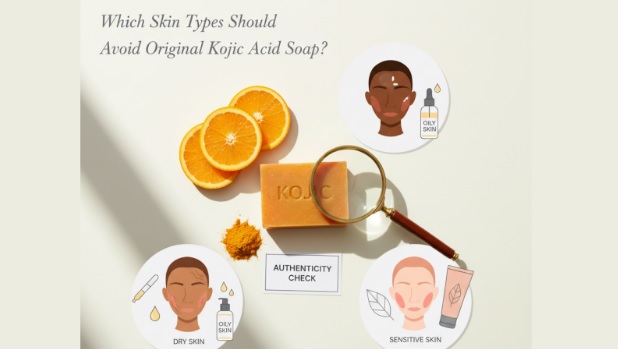Which Skin Types Should Avoid Original Kojic Acid Soap?
Kojic acid soap has gained huge attention in the skincare world for its brightening and pigmentation-reducing effects. Many people swear by its results — clearer, lighter, and smoother skin.
But does that mean it suits everyone?
Not really.
Every skin type reacts differently to active ingredients, making careful consideration essential. When you introduce kojic acid soap original into your routine, you’re working with a powerful exfoliating agent that targets dark spots and uneven skin tone.
However, while it can do wonders for some, it may cause irritation, dryness, or sensitivity in others.
So, how can you tell if this soap is right for you or not?
Let’s find out which skin types should proceed with caution — and what alternatives might be safer choices.
Why Skin Type Matters
Your skin’s natural oil balance, sensitivity level, and barrier strength decide how it reacts to ingredients like kojic acid. Some people may see glowing results, while others might end up with redness or flakiness. This soap works by inhibiting melanin production — the pigment responsible for dark spots — but overuse or using it on the wrong skin type can disrupt the skin’s barrier.
If you’re not sure whether to include it in your routine, start by learning how kojic acid functions and what its potential side effects are. Knowing your skin type before using active skincare can save you from unnecessary irritation or inflammation.
Skin Types That Should Be Cautious
Let’s break down which types of skin might not get along with kojic acid soap.
- Sensitive Skin
If your skin easily reacts to products with tingling, burning, or redness, it’s best to avoid strong actives. Kojic acid may be too harsh for such skin, especially when used daily. The compound can strip away natural oils, weakening your barrier and triggering irritation.
Tip: If you have sensitive skin but still want brightening benefits, try milder alternatives like rice water soap or vitamin C-based cleansers. - Very Dry Skin
Kojic acid works by lightly exfoliating the outer layer of your skin, which can worsen dryness. People with dry patches or flaking might notice more tightness or discomfort.
Solution: Use a rich, moisturizing cleanser instead, and limit exfoliating soaps to once or twice a week. Always follow up with a barrier-repair moisturizer. - Compromised or Damaged Skin Barrier
If your skin is currently irritated, peeling, or recovering from a breakout, introducing an exfoliating product can do more harm than good. The acid may cause stinging or worsen inflammation.
Solution: Wait until your skin has healed before trying kojic products. Focus first on barrier repair with ceramides and gentle hydration. - Eczema or Rosacea-Prone Skin
Conditions like eczema or rosacea make your skin extra sensitive to acids and exfoliants. Using such soaps can trigger flare-ups, itching, and redness.
Alternative: Look for fragrance-free, hypoallergenic cleansers approved for these conditions.
Who Can Safely Use It?
Oily and combination skin types often benefit the most from original kojic acid soap. This group tends to tolerate mild exfoliation better, and the soap helps control excess oil while brightening dull areas. However, even then, moderation is key. Use it once daily at most, and moisturize afterward to prevent dryness.
Before regular use, perform a patch test on a small area. If no irritation occurs within 24 hours, you can slowly introduce it to your routine.
Spotting the Real from the Fake
With so many counterfeit products on the market, verifying the original kojic brand is essential. Fake versions often contain harmful chemicals or poor-quality fillers that can irritate your skin.
Here’s how to perform a quick kojic soap authenticity check:
- Look for clear labeling, manufacturing details, and expiration date.
- Avoid soaps with overly strong scents or artificial coloring.
- Choose trusted stores or verified online sellers only.
- The real versions usually have a smooth texture and a mild citrus-like fragrance.
Using a genuine product ensures safety and effectiveness — especially when dealing with sensitive skin issues.
What to Do If You Experience a Reaction
Even if you’ve done your research, irritation can sometimes occur. If your skin feels itchy, tight, or red after using the soap:
- Stop using it immediately.
- Apply a calming, fragrance-free moisturizer.
- Avoid scrubbing or exfoliating for a few days.
- If the irritation persists, consult a dermatologist.
Never continue using the soap just to “push through” the reaction — it can lead to barrier damage or post-inflammatory hyperpigmentation.
Building a Balanced Routine
If you decide to use this soap, balance is key. Pair it with hydrating and soothing ingredients like:
- Hyaluronic acid – helps lock in moisture.
- Aloe vera – soothes irritation.
- Niacinamide – supports brightening without harshness.
Limit sun exposure, and always wear sunscreen, as kojic acid can make your skin more sun-sensitive.
Final Thoughts
Original kojic acid soap can be a strong ally in achieving brighter and more even-toned skin — but it’s not suitable for everyone. People with sensitive, dry, or reactive skin should proceed with caution or explore gentler alternatives. On the other hand, those with oily or combination types may find it a valuable addition when used correctly and sparingly.
Always remember: skincare isn’t one-size-fits-all. The right routine depends on your unique needs, tolerance, and consistency. When in doubt, consult a dermatologist before introducing new actives — your skin will thank you later.






